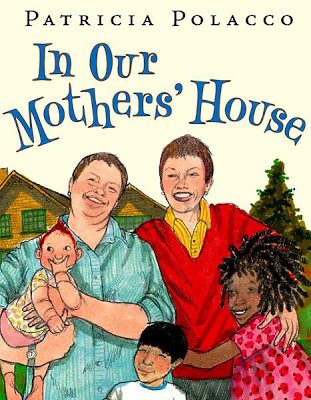
Title: In our Mothers’ House
Author/Illustrator: Patricia Polacco
Publisher: Philomel Productions Limited (2009)
Pages: 44
Genre: Realistic fiction
The story follows the narrator’s childhood, the oldest of three adopted siblings. Her mothers Meema and Marmee are loving, caring, and important members to the community. The children experience many different things from their Italian grandparents to their multicultural community fair. The family experiences many happy moments as the children grow up. They love these experiences and embrace their differences and make a home that the family can always come back to.
Probably one of the most diverse families I’ve ever seen portrayed in children’s literature, perhaps even adult literature for that matter, the family is comprised of two mothers perhaps both of Italian decent , only Meema was explicitly said to be so, the oldest daughter, a Black girl, the only son, an Asian boy, and the youngest, a bright colored redheaded girl.
As mentioned in the summary the narrator is told from the oldest daughter’s perspective (in the future looking back on the events). The text and the images complement each other as the story goes on. As each child is added to a family so too is their own sort of “origin” story of where they were before they arrived at the home. The mothers are portrayed as very capable people Meema being a pediatrician, and Marmee being a paramedic. Although, it is shown that their respective professions help them with things like taking care of the children when they are sick and organizational skills, the mothers’ are shown to be talented in things like cooking, sewing, and carpentry as well.
The children sometimes get into trouble too with Will, the only son, taking off a finial when the kids are sliding down the railings of the stairs, and Millie, the youngest, sleeping in the fireplace and using the coal and cinder to draw on the walls. Importantly though the children are not shown as “getting in trouble” for these things but rather they are just part of the experience of growing up. More than that in Millie’s case however where her drawings are even admired and celebrated. This is what I mean when I say embracing and celebrating difference. To that end, Meema’s parents, and specifically Nonno, the childrens’ grandfather adds to the diversity of the family at their family gathering in the house. He’s portrayed as a big, stout, boisterous Italian man who clearly loves his grandchildren and his family in general. He shows the children how to make gnocchi, a favorite activity of theirs.
However, the family doesn’t go entirely without discrimination. After a display of talent by Meema to sew the family’s Halloween costumes together Mrs. Lockner, a neighbor, is shown to be silently judgmental at the family and specifically glaring at the mothers. The mothers don’t bother explaining to the children why Mrs. Lockner acts this way at this point, but they do at their second in counter at a multicultural community event. Although a happy event where all the different families in the community bring food from their culture to share with everyone else, it has a relatively unfortunate end with Mrs. Lockner plainly saying “I don’t appreciate what you two are.”. Instead of getting angry it is explained as Mrs. Lockner being sacred of what she doesn’t understand. These events, it is important to note, are relatively small in comparison to how the rest of the book is. Although the discrimination is there, because the family is loving and accepting of each other they are, more specifically the eldest daughter is, to move past and resolve these issues within themselves quickly.
The children all grow up and move out of the house, but Marmee and Meema are always there, the children even bring their own children back to the home that they grew up in. Eventually the mothers pass away, as explained in the ending of the story, but the house and the love that they left in it will always remain.
Overall, this is an extraordinary book that truly celebrates how different people can be and the capacity to love those differences to live a vibrant and enriched life. Although you don’t really see how the discrimination from Mrs. Lockner affects the mothers, since the story is told through the daughter’s perspective, it’s clear that the love and care that the mothers provided meant so much more and had a much stronger impact on how the children lived their lives.
